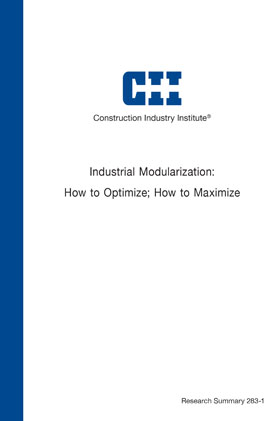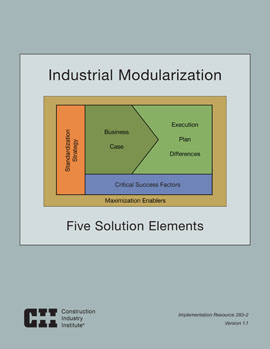
Industrial Modularization: How to Optimize; How to Maximize
The industrial sector of the capital projects industry is clearly in need of additional guidance on when and how to exploit the benefits of modularization. While the benefits of applying a modular approach to industrial projects—when compared to those of a conventional stick-built approach—can vary in nature and be very significant, the industry has been slow to achieve high levels of modularization. Some would say that the industry has hit a ceiling in terms of the percentage of stick-built work hours being exported offsite.
CII charged Research Team (RT) 283 with responding to this situation, and the team formulated its essential question in the following way:
What changes or adaptations in traditional project work processes are required to create an optimal environment for broader and more effective use of modularization?
Focusing on the industrial sector of the capital projects industry, the team sought to compare an idealized all-modular work process with current, largely stick-built work processes, and to identify key high-value practices that are in need of change. The research methodology included a literature review, surveys, case studies, and external validation, among other features.
Findings from this research led to the development of five distinct solution elements:
- a business case process
- execution plan differences
- critical success factors
- a standardization strategy
- modularization maximization enablers.
Because each of these elements is significant in its own way and should play an important role in achieving higher levels of modularization, industry leaders and project managers should be attentive to them.
- Business case process. The modularization business case process should be applied at the earliest opportunity. It should start as early as the Opportunity Framing phase and be analyzed in greater depth during the Assessment phase. For the industry to truly advance, project teams would be better served by making the modular approach the default approach.
- Execution plan differences. The research team identified more than 100 differences between how modular and stick-built projects should be planned and executed. Moreover, the team assigned these different planning and execution processes to their appropriate phases of implementation. Nearly half of them are applicable during the Basic Design phase.
- Critical success factors. The research team identified 21 high-impact critical success factors (CSFs), noting that the industry appears to be having difficulty achieving many of them. Owner responsibilities for CSF achievement during the Assessment and Selection phases are especially significant.
- Standardization strategy. The benefits of combining modularization with design standardization can exceed the additive sum, and therefore deserve special consideration. Two basic approaches exist: 1) the development of standardized modules; and 2) the development of modular standardized plants (MSPs). The business case for standardization should recognize 10 types of economic advantages and three types of economic disadvantages or tradeoffs. The research team developed an eight-step implementation process for the MSP strategy; the team also performed an MSP case study to provide further insight into strategy implementation.
- Modularization maximization enablers. Lastly, industry-wide barriers continue to challenge the broad-based application of modularization. The fifth solution element consists of a listing of 10 counter-measures to these industry-level challenges.
- Planning and cost estimating
- Modularization scoping, layout, and plot plan
- Basic design standards, models, and deliverables
- Detailed design deliverables
The team identified 21 high-impact CSFs and found that owner responsibilities for CSF achievement during the Assessment and Selection phases are especially significant. The industry appears to be having difficulty achieving CSFs that pertain to the following: (RS283-1, p. 16)
- Owner’s planning resources and processes
- Timely design freeze
- Early completion recognition
- Cost savings recognition
- Contractor leadership
- Investment in studies
- Vendor involvement
- Owner delay avoidance



